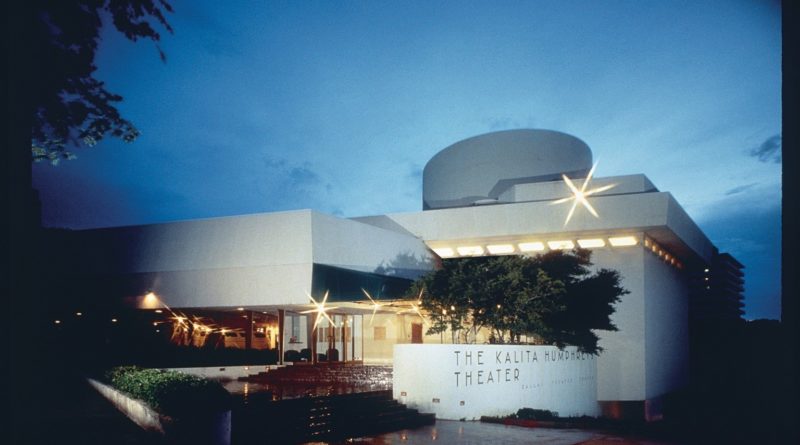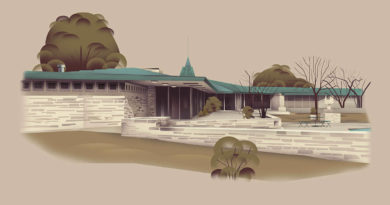Design Studio Picked, Now Public Comment Sought on Kalita Humphreys Theater
- Dallas panel selects Diller Scofidio + Renfro to develop master plan to renovate Frank Lloyd Wright-designed Kalita Humphreys Theater, upgrade site near Katy Trail
The Dallas Theater Center (DTC) announced Tuesday that distinguished New York interdisciplinary design studio Diller Scofidio + Renfro – whose work includes the redesign of the Lincoln Center for Performing Arts Campus and the Museum of Modern Art – will develop plans leading to renovation of Dallas’ famed Kalita Humphreys Theater, designed by Frank Lloyd Wright.
Those interested in learning more can attend a public information session, scheduled from 5:30 -7 p.m., Wednesday, March 4, at the Kalita Humphreys Theater. Diller Scofidio + Renfro will present their relevant past works, which will inform their design approach to the Kalita Humphreys master plan.
Attendees will be invited to provide written feedback that night or via a website set up for public comment. A link to the Kalita Humphreys master plan feedback site will be posted on DTC’s website, dallastheatercenter.org.
 The building has been home to DTC since its opening in 1959, and the renovation efforts aim to preserve the theater’s distinct architecture while equipping it to inspire a new generation. A steering committee made up of diverse community stakeholders selected Diller Scofidio + Renfro after a thorough selection process, and the firm – with DTC – will develop a master plan for the theater and the nine-acre Kalita Humphreys site, which will include new theater spaces and a connection to the Katy Trail.
The building has been home to DTC since its opening in 1959, and the renovation efforts aim to preserve the theater’s distinct architecture while equipping it to inspire a new generation. A steering committee made up of diverse community stakeholders selected Diller Scofidio + Renfro after a thorough selection process, and the firm – with DTC – will develop a master plan for the theater and the nine-acre Kalita Humphreys site, which will include new theater spaces and a connection to the Katy Trail.
Hillwood Urban will be the project manager, overseeing the drive to restore the theater to its historic period of significance, while improving its ability to function as a modern working theater.
In keeping with Wright’s organic, nature-inspired vision, the master plan will connect the Katy Trail, Dean Park and the surrounding neighborhoods of Uptown, Turtle Creek and Oak Lawn to the Kalita Humphreys Campus, making the entire site an accessible public space for all.
The Kalita Humphreys Theater is unique among Wright’s distinguished body of work as the only free-standing theater he designed that was built during his lifetime. Its most notable internal feature is a revolving stage which exemplifies Wright’s Organic Theory of architecture, which stressed the unification of the building’s form and function, the harmony of the building’s structure with its natural setting, and the aesthetically pleasing manipulation of space. Like all of Wright’s projects, the theater’s design was considered bold and innovative for its time. Wright also stressed integration with nature, and the theater was built into a limestone bluff overlooking Turtle Creek.
“All of us at Dallas Theater Center have been proud to call the Kalita Humphreys Theater our home since it was completed 61 years ago,” said DTC Artistic Director Kevin Moriarty. “As we look to the future, we are thrilled to partner with the architects at Diller Scofidio + Renfro as well as the city of Dallas and the entire community to restore the Kalita to its original glory, and expand opportunities for theater artists, students and audiences. By creating new spaces and opening up the site, the new master plan will boost the natural beauty of the theater’s surroundings and improve its ability to serve as a welcoming, accessible space for all.”
“The renovations to the Kalita Humphreys Theater will prepare it to host productions by Dallas Theater Center and other theater companies for generations to come, while honoring the beauty and innovation of Frank Lloyd Wright’s original design,” Jennifer Altabef, chair of the DTC’s board, said.
“In addition, the creation of two smaller theaters will allow DTC and other local companies to perform regularly on the site, in harmony with the goals of the new Dallas Cultural Plan. We will work with Dallas’ Office of Arts and Culture and the theater community to make this incredible asset available to more theater companies and audiences,” she added.
Charles Renfro will lead the development of the master plan in collaboration with his partners at Diller Scofidio + Renfro. This is a deeply personal project for Renfro, who was raised in Baytown, Texas, and traces his love of architecture to the state’s modernist icons. After graduating from Rice University in Houston and Columbia University in New York, he practiced at a number of firms before joining Diller + Scofidio in 1997 and becoming a partner in 2004.
He has since worked on a number of projects significant to New York, including the redesign of the MoMA, the Lincoln Center for Performing Arts and the High Line. He has run multiple projects in California, including The Broad, a contemporary art museum in Los Angeles, and academic facilities for University of California at Berkeley and Stanford University.
Renfro has maintained his connection to Texas, presenting new ideas for urban regeneration to the Houston Park Board. DTC said his experience as well as Diller Scofidio + Renfro’s history of creating aesthetically appealing and accessible public buildings and public spaces made Renfro and the firm a natural choice for this high-profile project.
“As a native Texan, I am particularly excited to contribute to our state’s architectural heritage and partner with Dallas Theater Center, whose bold productions are equally matched by their bold commitment to architectural innovation,” Renfro said. “This project is an opportunity to restore the Kalita Humphreys – one of Dallas’s most overlooked pieces of architecture – to its rightful place in the pantheon of design masterpieces in the city. Not only is it Frank Lloyd Wright’s only built theater, but it has also made significant contributions to the way theater has been presented and seen.”
“Since it was built, the theater’s bucolic setting between Turtle Creek and the Katy Trail has been overwhelmed by parking lots and roadways. Our approach will seek to slow the site down and add new architecturally significant programs grown out of the surrounding urban green. The Kalita Humphreys complex will be an idyllic and iconic refuge surrounded by nature, merely footsteps away from the bustling city,” he said.
DTC and its partners intend to present a plan to the city’s Office of Arts and Culture by the end of 2020. The Dallas City Council will be asked to give final approval of the plan.
Read Peter Simek’s take over at our sister publication, D Magazine.







